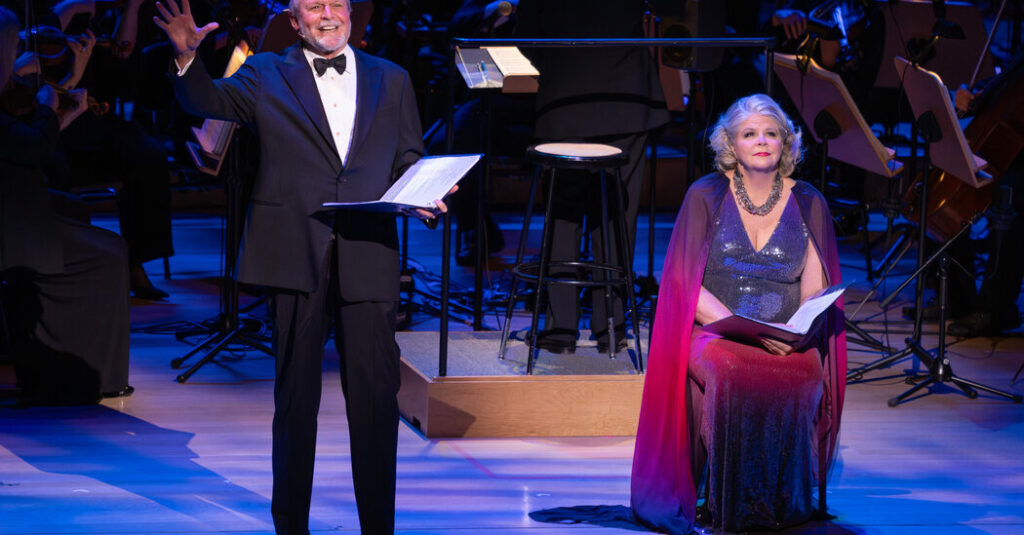Where Can Sondheim’s Operatic Musicals Find a Home?

Near the end of Stephen Sondheim’s musical “A Little Night Music,” the orchestra swells to what he is said to have called his Max Steiner moment, something out of “Casablanca” or “Gone With the Wind.”
Désirée and Fredrik, former lovers who reconnect but nearly miss out on happiness again, come together and kiss. The instruments respond with a grand, emotive reprise of the show’s 11 o’clock number, “Send in the Clowns.”
At a concert performance of “A Little Night Music” at David Geffen Hall on Thursday, the premiere of a new orchestration by Sondheim’s longtime collaborator Jonathan Tunick, the 53-piece Orchestra of St. Luke’s let out a fortissimo tutti. Strings and winds soared with the melody, but there was more: resonant, staggered chords to support it in the low voices, and florid counterpoint. It was a moment fit not only for the movies but for the opera house, which, perhaps, is where this new orchestration belongs.
Not all musicals are fit for stages beyond Broadway, but some are. And there has been a resurgence, since Sondheim’s death in 2021, of large-scale revivals of his work. (This, after years of skillfully stripped-down productions by John Doyle.) “Sweeney Todd” returned to Broadway with Tunick’s original orchestration for nearly 30 players, crackling with detail and musical drama. Last week, “Follies” was presented at Carnegie Hall with a similarly sized ensemble and a starry cast in concert.
The version of “A Little Night Music” on Thursday had nearly double those forces. If anyone can be trusted with that task, it’s Tunick. He and Sondheim first collaborated on “Company,” in 1970, and Tunick orchestrated the composer’s final, unfinished show, “Here We Are,” last year.
The two had a miraculously simple way of working together. Sondheim would play through and sing his scores at a piano, and, based on his touch and vocal shading, Tunick would have enough to draw on for the orchestration, teasing out the sound world of each piece. Sondheim was satisfied, and so were the entertainment academies: Tunick belongs in the elite class of EGOT artists who have won an Emmy, a Grammy, an Oscar and a Tony. This month, he won another Tony, for orchestrating the hit revival of Sondheim’s “Merrily We Roll Along.”
Since the original runs of Sondheim’s shows, Tunick has adapted the scores for a variety of ensembles. He can scale in either direction; the “Merrily” revival has a pit band of just 13 musicians. “Merrily” can withstand that kind of reduction, in part because of Tunick’s brilliance, but also because of the show’s architecture. Some works, though, thrive in grandeur, like “Sweeney” and “Follies” and, yes, “A Little Night Music.”
I have heard of “A Little Night Music” referred to as Sondheim’s “Rosenkavalier,” and that’s not too generous. Sondheim’s score, one of his finest, shares with Strauss a fin-de-siècle, dreamily waltzing sensibility, and themes about the foolishness of love and the passage of time. In both, there is wisdom behind the comedy.
Sondheim described his score as a theme and variations. Numbers, interludes and underscoring are set in waltzy time signatures of three beats: 3/4, 3/2, 6/8 and so on, with dancing styles like the mazurka and polonaise. The first act’s finale resembles an opéra bouffe, with eight vocal lines layered in Mozartean neatness and inevitability.
The new orchestration by Tunick is, on the whole, recognizably the same show, but subtly richer, its complexity rendered with fresh clarity. (One novelty is the restoration of “Silly People,” a song cut early in the show’s out-of-town tryout.) The structure of Sondheim’s score comes out better for it: With Tunick’s contribution, it has less the oom-pah-pah support of basic songwriting, and more the sense of an integrated whole in which vocal and instrumental lines are equally essential.
There is sophisticated counterpoint in “Now,” and Ravelian perfume surrounding “Liaisons.” Waltzes have the sumptuousness of a Vienna Philharmonic New Year’s concert, with touches like a love-drunk harp and fluttering flute. The big tutti in the “Send in the Clowns” reprise was so powerful on Thursday, it was easily heard even over the audience’s applause.
This was a presentation with a lot of luxury in scale and casting, though not, seemingly, in rehearsal time. The singers involved, like the opera star Susan Graham as Désirée and Cynthia Erivo as Petra, would suggest that the Geffen Hall run will improve over its three additional performances. But it wasn’t ready for an opening-night audience on Thursday.
It moved quickly, in a concert adaptation of Hugh Wheeler’s book by Doyle, and with a light touch by the director Marc Bruni, who kept things simple, emphasizing small gestures over elaborate theater. But maybe not quickly enough; Tunick conducted with slow tempos that often restrained the teeming score. It was like watching someone hold back a dog that pulls on its leash. The music wants to run. (Tunick may know this show inside and out, but even Stravinsky wasn’t the best interpreter of his own music.)
The Orchestra of St. Luke’s played with the kind of mixed confidence heard throughout the cast. Graham sang with ease and charisma, but during “You Must Meet My Wife” had to feed lines to Ron Raines as Fredrik; sometimes, you can fudge lyrics, but not ones with the precision and wit of Sondheim’s. Kerstin Anderson’s brightly clear Anne was a high point, pairing well with Jason Gotay’s impassioned Henrik; and Erivo was appropriately cheered for her scene-stealing turn in “The Miller’s Son.” Ruthie Ann Miles, the Beggar Woman in the recent “Sweeney” revival, was an amusingly acidic Countess Charlotte, but with barely repressed heartbreak, like another famous countess of opera, in “Le Nozze di Figaro.”
In its clumsiness and lack of balance, with amplification and orchestration often working against each other, this performance seemed to represent the problem of where “A Little Night Music” might find a proper home. It’s too difficult to hastily throw onstage. In the past, it was programmed at New York City Opera, which is now more or less dead. A run at Encores!, where Tunick’s immense orchestration of “Titanic” was just heard, would be too brief.
What this show deserves is a place in the repertoire, with the resources it needs to thrive. Tunick has done his part. Who will take it from here?
where-can-sondheims-operatic-musicals-find-a-home




